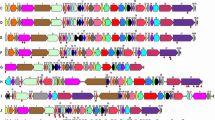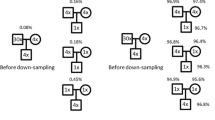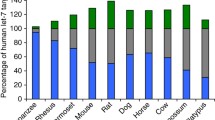Abstract
Fragile X syndrome, the most common inherited form of mental retardation, arises in individuals with more than 200 CGG repeats in the 5′ untranslated region of the fragile X mental retardation 1 (FMR1) gene. Although CGG repeat numbers comparable to those found in the normal human population are found in various non-human primates, neither the within-species size variation nor the propensity for expansion of the CGG repeat has been described for any non-human primate species. The allele distribution has now been determined for FMR1 (homologue) CGG repeats of 265 unrelated founder females of Macaca mulatta monkeys. Among 530 X chromosomes, at least 26 distinct repeat lengths were identified, ranging from 16 to 54 CGG repeats. Of these alleles 79% have between 25 and 33 CGG repeats. Detailed examination of the CGG region revealed a conserved G (CGG)2 G interruption, although in no case was an AGG trinucleotide detected. Two animals carried borderline premutation alleles with 54 CGG repeats, within the region of marginal instability for humans. Thus, M. mulatta may be useful as an animal model for the study of fragile X syndrome.



Similar content being viewed by others
References
Arinami T, Asano M, Kobayashi K, Yanagi H, Hamaguchi H (1993) Data on the CGG repeat at the fragile X site in the non-retarded Japanese population and family suggest the presence of a subgroup of normal alleles predisposing to mutate. Hum Genet 92:431–436
Ashley CT, Sutcliffe JS, Kunst CB, Leiner HA, Eichler EE, Nelson DL, Warren ST (1993) Human and murine FMR-1: alternative splicing and translational initiation downstream of the CGG-repeat. Nat Genet 4:244–251
Bardoni B, Schenck A, Mandel JL (2001) The fragile X mental retardation protein. Brain Res Bull 56:375–382
Bontekoe CJ, Bakker CE, Nieuwenhuizen IM, van der Linde H, Lans H, de Lange D, Hirst MC, Oostra BA (2001) Instability of a (CGG)98 repeat in the FMR1 promoter. Hum Mol Genet 10:1693–1699
Brown WT, Nolin S, Houck G Jr, Ding X, Glicksman A, Li SY, Stark-Houck S, Brophy P, Duncan C, Dobkin C, Jenkins E (1996) Prenatal diagnosis and carrier screening for fragile X by PCR. Am J Med Genet 64:191–195
Chiurazzi P, Macpherson J, Sherman S, Neri G (1996) Significance of linkage disequilibrium between the fragile X locus and its flanking markers (editorial). Am J Med Genet 64:203–208
Consortium TD-BFX (1994) FMR1 knockout mice: a model to study fragile X mental retardation. Cell 78:23–33
Crawford DC, Wilson B, Sherman SL (2000a) Factors involved in the initial mutation of the fragile X CGG repeat as determined by sperm small pool PCR. Hum Mol Genet 9:2909–2918
Crawford DC, Zhang F, Wilson B, Warren ST, Sherman SL (2000b) Fragile X CGG repeat structures among African-Americans: identification of a novel factor responsible for repeat instability. Hum Mol Genet 9:1759–1769
Crawley JN, Paylor R (1997) A proposed test battery and constellations of specific behavioral paradigms to investigate the behavioral phenotypes of transgenic and knockout mice. Horm Behav 31:197–211
Deelen W, Bakker C, Halley DJ, Oostra BA (1994) Conservation of CGG region in FMR1 gene in mammals. Am J Med Genet 51:513–516
Djian P (1998) Evolution of simple repeats in DNA and their relation to human disease. Cell 94:155–160
Dombrowski C, Levesque S, Morel ML, Rouillard P, Morgan K, Rousseau F (2002) Premutation and intermediate-size FMR1 alleles in 10,572 males from the general population: loss of an AGG interruption is a late event in the generation of fragile X syndrome alleles. Hum Mol Genet 11:371–378
Eichler EE, Kunst CB, Lugenbeel KA, Ryder OA, Davison D, Warren ST, Nelson DL (1995) Evolution of the cryptic FMR1 CGG repeat. Nat Genet 11:301–308
Eichler EE, Nelson DL (1996) Genetic variation and evolutionary stability of the FMR1 CGG repeat in six closed human populations. Am J Med Genet 64:220–225
Faradz SM, Pattiiha MZ, Leigh DA, Jenkins M, Leggo J, Buckley MF, Holden JJ (2000) Genetic diversity at the FMR1 locus in the Indonesian population. Ann Hum Genet 64:329–339
Fu YH, Kuhl DP, Pizzuti A, Pieretti M, Sutcliffe JS, Richards S, Verkerk AJ, Holden JJ, Fenwick RG Jr, Warren ST, et al. (1991) Variation of the CGG repeat at the fragile X site results in genetic instability: resolution of the Sherman paradox. Cell 67:1047–1058
Gunter C, Paradee W, Crawford DC, Meadows KA, Newman J, Kunst CB, Nelson DL, Schwartz C, Murray A, Macpherson JN, Sherman SL, Warren ST (1998) Re-examination of factors associated with expansion of CGG repeats using a single nucleotide polymorphism in FMR1. Hum Mol Genet 7:1935–1946
Jin P, Warren ST (2000) Understanding the molecular basis of fragile X syndrome. Hum Mol Genet 9:901–908
Kallinen J, Heinonen S, Mannermaa A, Ryynanen M (2000) Prenatal diagnosis of fragile X syndrome and the risk of expansion of a premutation. Clin Genet 58:111–115
Kunst CB, Warren ST (1994) Cryptic and polar variation of the fragile X repeat could result in predisposing normal alleles. Cell 77:853–861
Musumeci SA, Bosco P, Calabrese G, Bakker C, De Sarro GB, Elia M, Ferri R, Oostra BA (2000) Audiogenic seizures susceptibility in transgenic mice with fragile X syndrome. Epilepsia 41:19–23
Nolin SL, Glicksman A, Houck GE Jr, Brown WT, Dobkin CS (1994) Mosaicism in fragile X affected males. Am J Med Genet 51:509–512
Nolin SL, Brown WT, Glicksman A, Houck GE Jr, Gargano AD, Sullivan A, Biancalana V, Brondum-Nielsen K, Hjalgrim H, Holinski-Feder E, Kooy F, Longshore J, Macpherson J, Mandel JL, Matthijs G, Rousseau F, Steinbach P, Vaisanen ML, Von Koskull H, Sherman SL (2003) Expansion of the fragile X CGG repeat in females with premutation or intermediate alleles. Am J Hum Genet 72:454–464
Nowak RM (1990) Walker's mammals of the world, 5th edn. The Johns Hopkins University Press, Baltimore and London
O'Donnell WT, Warren ST (2002) A decade of molecular studies of fragile X syndrome. Annu Rev Neurosci 25:315–338
Oostra BA, Chiurazzi P (2001) The fragile X gene and its function. Clin Genet 60:399–408
Pang CP, Poon PM, Chen QL, Lai KY, Yin CH, Zhao Z, Zhong N, Lau CH, Lam ST, Wong CK, Brown WT (1999) Trinucleotide CGG repeat in the FMR1 gene in Chinese mentally retarded patients. Am J Med Genet 84:179–183
Pesso R, Berkenstadt M, Cuckle H, Gak E, Peleg L, Frydman M, Barkai G (2000) Screening for fragile X syndrome in women of reproductive age. Prenat Diagn 20:611–614
Pieretti M, Zhang FP, Fu YH, Warren ST, Oostra BA, Caskey CT, Nelson DL (1991) Absence of expression of the FMR-1 gene in fragile X syndrome. Cell 66:817–822
Richards RI, Sutherland GR (1997) Dynamic mutation: possible mechanisms and significance in human disease. Trends Biochem Sci 22:432–436
Rousseau F, Rouillard P, Morel ML, Khandjian EW, Morgan K (1995) Prevalence of carriers of premutation-size alleles of the FMRI gene—and implications for the population genetics of the fragile X syndrome. Am J Hum Genet 57:1006–1018
Rubinsztein DC, Amos W, Leggo J, Goodburn S, Ramesar RS, Old J, Bontrop R, McMahon R, Barton DE, Ferguson-Smith MA (1994a) Mutational bias provides a model for the evolution of Huntington's disease and predicts a general increase in disease prevalence. Nat Genet 7:525–530
Rubinsztein DC, Leggo J, Amos W, Barton DE, Ferguson-Smith MA (1994b) Myotonic dystrophy CTG repeats and the associated insertion/deletion polymorphism in human and primate populations. Hum Mol Genet 3:2031–2035
Sharma D, Gupta M, Thelma BK (2001) Expansion mutation frequency and CGG/GCC repeat polymorphism in FMR1 and FMR2 genes in an Indian population. Genet Epidemiol 20:129–144
Sinden RR (1999) Biological implications of the DNA structures associated with disease-causing triplet repeats. Am J Hum Genet 64:346–353
Toledano-Alhadef H, Basel-Vanagaite L, Magal N, Davidov B, Ehrlich S, Drasinover V, Taub E, Halpern GJ, Ginott N, Shohat M (2001) Fragile-X carrier screening and the prevalence of premutation and full-mutation carriers in Israel. Am J Hum Genet 69:351–360
Turner G, Webb T, Wake S, Robinson H (1996) Prevalence of fragile X syndrome. Am J Med Genet 64:196–197
Vries BB de, van den Ouweland AM, Mohkamsing S, Duivenvoorden HJ, Mol E, Gelsema K, van Rijn M, Halley DJ, Sandkuijl LA, Oostra BA, Tibben A, Niermeijer MF (1997) Screening and diagnosis for the fragile X syndrome among the mentally retarded: an epidemiological and psychological survey. Collaborative Fragile X Study Group. Am J Hum Genet 61:660–667
Wan L, Dockendorff TC, Jongens TA, Dreyfuss G (2000) Characterization of dFMR1, a Drosophila melanogaster homolog of the fragile X mental retardation protein. Mol Cell Biol 20:8536–8547
Zhang YQ, Bailey AM, Matthies HJ, Renden RB, Smith MA, Speese SD, Rubin GM, Broadie K (2001) Drosophila fragile X-related gene regulates the MAP1B homolog Futsch to control synaptic structure and function. Cell 107: 591–603
Zhong N, Yang W, Dobkin C, Brown WT (1995) Fragile X gene instability: anchoring AGGs and linked microsatellites. Am J Hum Genet 57:351–361
Zhong N, Ju W, Pietrofesa J, Wang D, Dobkin C, Brown WT (1996) Fragile X "gray zone" alleles: AGG patterns, expansion risks, and associated haplotypes. Am J Med Genet 64:261–265
Acknowledgements
We wish to thank Dr. Phil Allen from the California Regional Primate Research Center for blood extraction coordination, Dr. Flora Tassone for her help with sequencing protocols, and Diem-Phuong Tran for her assistance in characterizing CGG repeats. This research was supported, in part, by the Leonard/Clark and Boory Family Funds.
Author information
Authors and Affiliations
Corresponding author
Rights and permissions
About this article
Cite this article
Garcia Arocena, D., Breece, K.E. & Hagerman, P.J. Distribution of CGG repeat sizes within the fragile X mental retardation 1 (FMR1) homologue in a non-human primate population. Hum Genet 113, 371–376 (2003). https://doi.org/10.1007/s00439-003-0982-9
Received:
Accepted:
Published:
Issue Date:
DOI: https://doi.org/10.1007/s00439-003-0982-9




